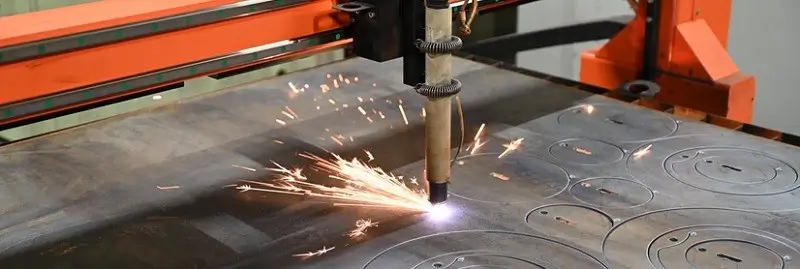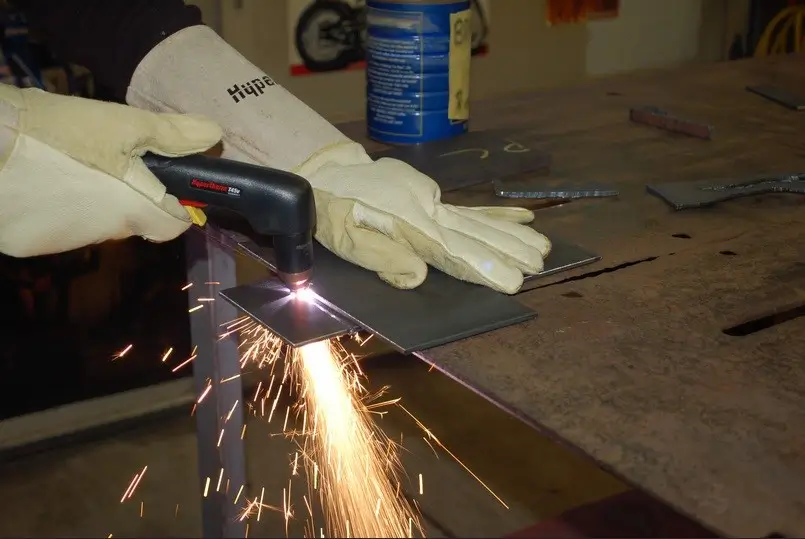
If you’ve ever wondered how plasma cutting works, the answer lies in one of the most impressive examples of modern engineering: turning electricity and gas into a jet of lightning that slices through metal with precision. Plasma cutting technology uses an electrically charged gas stream—called plasma—to melt and remove material, creating clean, accurate cuts in seconds. In this guide, we’ll break down how plasma cutting actually works, what makes it different from laser cutting, and why it’s become a cornerstone of today’s metal fabrication industry.

You probably know about the three common states of matter: solid, liquid, and gas. But did you know there’s a fourth one called plasma? It’s often described as an “ionized gas,” made up of free electrons and charged particles that move at high speeds. Unlike ordinary gases, plasma conducts electricity and responds strongly to magnetic and electric fields. So Plasma cutting is a thermal cutting technology that transforms electrical energy into a high-velocity jet of ionized gas capable of slicing through conductive metals with remarkable precision.
Today, plasma cutting technology plays a vital role in metal fabrication and heavy manufacturing industries. From construction and shipbuilding to the production of large industrial valves and machinery, it enables faster operations, reduced material waste, and higher accuracy compared to older cutting techniques.
While the science explains why plasma cutting works, understanding how it happens in practice helps operators use the technology efficiently. The cutting process can be summarized in a few key stages:

A plasma cutting system may seem complex at first, but it is made up of a few key components that work together to create precise and efficient cuts. In the table below, you can see the main components of a plasma cutting system and their primary functions:
| Component | Function | Explanation |
| Plasma Torch | Generates the plasma arc | Houses the electrode and nozzle; directs the ionized gas stream to the metal for cutting. |
| Nozzle | Shapes the plasma jet | Focuses the plasma stream into a narrow, high-velocity jet for precise cuts. |
| Power Supply | Provides electrical energy | Converts standard electrical input into the high-current arc needed for plasma generation. |
| Gas Supply | Supplies compressed gas | Provides air, nitrogen, or other gases that become ionized to form plasma. |
| Workpiece/Table | Supports the metal | Holds the metal in place during cutting; may include CNC movement for automation. |
| Control System (Manual or CNC) | Controls cutting parameters | Regulates torch movement, cutting speed, and arc stability for precision. |
| Fume Extraction System | Ensures safe environment | Removes smoke, molten particles, and harmful fumes from the cutting area. |
Plasma cutting systems come in different types and configurations, each designed to meet specific industrial or commercial needs. Below are the most common types used across workshops and manufacturing facilities:
Handheld plasma cutters are compact, portable tools designed for flexibility and convenience. They are ideal for on-site repairs, light metal fabrication, and small-scale projects. Because they are lightweight and easy to operate, these machines are widely used by technicians, artists, and small manufacturers.
They are best suited for cutting thin to medium-thickness metals such as steel or aluminum, delivering clean results with minimal setup.
CNC (Computer Numerical Control) plasma cutters bring automation and precision to metal cutting. These machines follow programmed cutting paths, ensuring consistent and repeatable results.
CNC plasma cutting systems are typically used in industrial production environments, where accuracy, speed, and the ability to cut complex shapes are critical. They are the go-to choice for construction, shipbuilding, and heavy machinery manufacturing.
Plasma cutters can also be categorized by the way their arc is initiated:
In advanced manufacturing, robotic plasma cutting takes automation a step further. Using robotic arms integrated with CNC control, these systems deliver high precision and repeatability while minimizing manual labor.
Robotic plasma cutting is widely adopted in automotive, aerospace, and shipbuilding industries, where accuracy, efficiency, and worker safety are paramount. These systems also help improve production speed and ensure consistent cut quality across large volumes.

| Type of Plasma Cutter | Precision Level | Main Applications | Relative Cost |
| Handheld Plasma Cutter | Medium | On-site repairs, small workshops, artistic metalwork | Low |
| CNC Plasma Cutting Machine | High | Industrial manufacturing, construction, shipbuilding | Medium–High |
| High-Frequency Plasma Cutter | High | Cutting thick metals, heavy fabrication industries | Medium–High |
| Low-Frequency (Pilot Arc) Plasma Cutter | Medium | Environments sensitive to electromagnetic interference | Low–Medium |
| Robotic Plasma Cutting System | Very High | Automotive, aerospace, automated production lines | High |
A plasma cutting machine can handle a wide range of conductive metals with impressive precision — from thin sheets to heavy industrial plates. Whether you’re working in construction, shipbuilding, or automotive manufacturing, plasma cutting provides clean and efficient results across various materials. Below is a list of metals commonly cut using plasma systems:
The most common material used in industrial fabrication. Plasma cutters easily slice through mild steel up to several inches thick, making it ideal for heavy-duty structural work.
Known for its corrosion resistance, stainless steel can be precisely cut using CNC plasma cutting without compromising edge quality or surface finish.
Despite being lightweight and reflective, aluminum responds very well to plasma cutting — especially with high-frequency and inverter-based systems.
Although these metals conduct heat rapidly, modern plasma machines can handle them efficiently using specific gas combinations like nitrogen or argon-hydrogen.
A frequent choice in construction and HVAC industries. Plasma cutting ensures smooth, burr-free edges without damaging the protective zinc coating.
Cast iron can be plasma cut, though it often requires slower speeds and more controlled current to avoid cracking.
Like any industrial cutting method, plasma cutting offers both impressive strengths and certain limitations. Understanding these helps you choose the right process for your material, production volume, and precision requirements.
Working with plasma cutting systems requires proper safety measures and adherence to industrial standards to ensure both operator protection and consistent cut quality. Since the process involves high temperatures, electric currents, and pressurized gases, safety cannot be compromised at any stage.
Every operator should wear:
Plasma cutting works best on conductive metals such as mild steel, stainless steel, aluminum, copper, and brass. Non-conductive materials like plastic or wood cannot be cut with this method.
The maximum cutting thickness depends on the machine power and type of torch. Industrial plasma systems can handle up to 150 mm (6 inches) of steel, while handheld machines typically cut between 10–30 mm efficiently.
Yes, as long as proper safety measures are followed. Operators should use protective equipment, ensure good ventilation or fume extraction systems, and keep the workspace free of flammable materials.
Regular maintenance includes checking cables, replacing consumables like nozzles and electrodes, cleaning filters, and ensuring stable power supply. Periodic calibration helps maintain precision and reduce downtime.